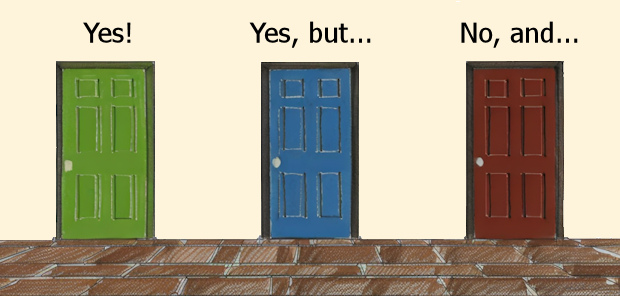
Disaster
After struggling through the conflict, readers are eager to learn what happens to the character. As soon as a character has a goal, the reader asks themselves an important question:
Will the character attain their goal?
We’ve seen how adding conflict adds uncertainty to this question. But once the obstacles have been dealt with, it’s time to decide what fate has in store for your character. There are three ways to answer the question “will the character attain their goal?”:

Option 1: Yes
Your character has struggled, has overcome all the obstacles in their path, and finally obtains what they wanted.
Readers root for characters they like. When characters are victorious, readers celebrate with them, especially when the victory feels earned and well-deserved.
However, if your character is always successful, your readers begin to lose interest because the story becomes too predictable. Imagine a story where Superman does nothing but catch petty criminals every day. He subdues the bad guys with his superpowers with ease. In fact, when he first makes his appearance as Superman in the 1978 movie, he does just that before moving on to face Lex Luthor where the stakes are much higher.
It’s not uncommon to give your characters early successes so that your readers get a sense of your character’s strengths and abilities. Many action stories do so to establish the hero’s unique superpowers or skills.
As a writer, if you wrap up a scene “too neatly,” there’s no obvious next step to the story. Of course, you might end the story on such a note, however, a completely satisfied goal in the middle of a story will require a major change in direction to keep the story going.
Option 2: Yes, but...
Option 3: No, and...
Your character doesn’t achieve their goal and now they’re even worse off than before. This option is also known as “the disaster,” because it represents a major setback for our character.
A disaster for your protagonist might represent a major victory for an antagonist. As with Option 2 (Yes, but…), there’s added uncertainty. An important question arises in the reader’s mind: what will the character do now?
The character’s original goal is no longer attainable. It needs to be replaced with a new one, requiring a completely different approach.
Which outcome should you use for your scene?
As a writer, that’s up to you. However…consider that Dwight Swain (who came up with the Goal-Conflict-Disaster sequence for scenes) named the outcome ‘Disaster,’ probably because this outcome is the most suspenseful option. Does that mean all your scenes should end in disaster?
Probably not all of them.
Consider all three options and decide which benefits your story the most.
Regardless of which approach you pick, the character needs to respond to outcome of their conflict. That’s the focus of the next scene component: Reaction.
Icons made by Freepik from www.flaticon.com
